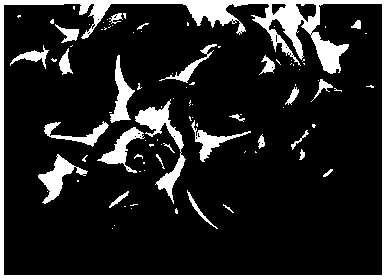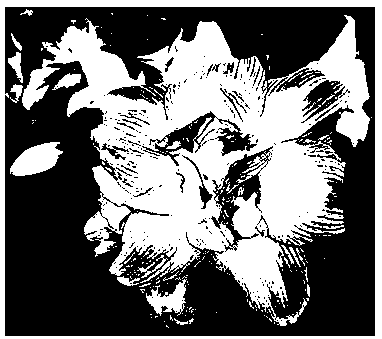Double-petal barbadoslily cultivation method
A technology of Hippeastrum double petals and breeding methods, which is applied in the field of cultivating Hippeastrum double petals varieties, can solve problems such as difficult to meet market demand, high price of bulbs, difficult market demand, etc., achieve shortening of Hippeastrum breeding cycle, improve breeding efficiency, and meet the needs of the market. The effect of market demand
- Summary
- Abstract
- Description
- Claims
- Application Information
AI Technical Summary
Problems solved by technology
Method used
Image
Examples
Embodiment 1
[0037] A method for cultivating Hippeastrum double petals is characterized in that comprising the following steps:
[0038] 1) At the beginning of October of that year, the double-petaled variety 'Hua Peacock' (see figure 1 ), Hippeastrum single-petal variety ‘Amores’ (see figure 2 ) after the bulbs are harvested, store them in a ventilated darkroom at 4°C until the end of December, then adjust the temperature in the darkroom to 20°C, and continue to store them until the end of January next year. Place in a greenhouse at 18°C and water once every 3 days until the double-petal bulbs and single-petal bulbs germinate. Grow in the greenhouse at a temperature of 18°C and water every 3 days until the single-petal Hippeastrum blooms in mid-March;
[0039] 2) The double-petaled bulbs removed from the pots are grown in a greenhouse with a daytime temperature of 28°C and a nighttime temperature of 20°C, and water is replenished in due course until the double-petaled Hippeastrum b...
Embodiment 2
[0060] A method for cultivating Hippeastrum double petals is characterized in that comprising the following steps:
[0061] 1) At the beginning of October of that year, after harvesting the bulbs of the double-petal variety 'Flower Peacock' and the single-petal variety Amaryllis', the bulbs were stored in a ventilated darkroom at 8°C until the end of December, and then the darkroom was adjusted When the temperature reaches 25°C, continue to store until the end of January next year, plant them in pots respectively, place the potted bulbs in a greenhouse at 25°C, and water once every 3 days until double-petal bulbs and single-petal bulbs Germinate. After the buds of the germinated double-petal bulbs break through the soil, they are removed from the pots. The single-petal bulbs continue to grow in the greenhouse at a temperature of 25°C and watered once every 3 days until mid-March. Petal Hippeastrum blooms;
[0062] 2) The double-petalled bulbs removed from the pots are grown i...
Embodiment 3
[0083] A method for cultivating Hippeastrum double petals is characterized in that comprising the following steps:
[0084] 1) At the beginning of October of that year, after harvesting the bulbs of the double-petaled variety 'Hua Peacock' and the single-petaled variety Amaryllis', the bulbs were stored in a ventilated darkroom at 6°C until the end of December, and then the darkroom was adjusted When the temperature reaches 23°C, continue to store until the end of January next year, plant them in pots respectively, place the potted bulbs in a greenhouse at 23°C, and water once every 3 days until the double-petal bulbs and single-petal bulbs Germinate. After the buds of the germinated double-petal bulbs break through the soil, they are removed from the pots. The single-petal bulbs continue to grow in the greenhouse at a temperature of 23 ° C and watered once every 3 days until mid-March. Petal Hippeastrum blooms;
[0085] 2) The double-petalled bulbs removed from the pots are ...
PUM
 Login to View More
Login to View More Abstract
Description
Claims
Application Information
 Login to View More
Login to View More - R&D
- Intellectual Property
- Life Sciences
- Materials
- Tech Scout
- Unparalleled Data Quality
- Higher Quality Content
- 60% Fewer Hallucinations
Browse by: Latest US Patents, China's latest patents, Technical Efficacy Thesaurus, Application Domain, Technology Topic, Popular Technical Reports.
© 2025 PatSnap. All rights reserved.Legal|Privacy policy|Modern Slavery Act Transparency Statement|Sitemap|About US| Contact US: help@patsnap.com



